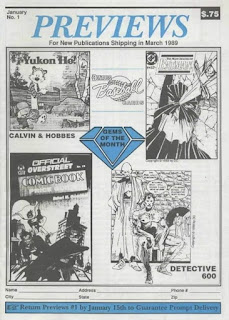Diamond has had a monopoly on comics distribution for some time now, so their Previews catalog is often considered the go-to source for upcoming comics material. The telephone book of orderable goods comes in at around 600 pages every month, and it's not uncommon to hear retailers lament having to sort through everything.
But that wasn't always the case! Naturally, there was a time before Diamond existed, and they didn't start sending out what might be considered a catalog of material until after they'd enlarged to a national scope in the late 1980s. The first Previews catalog was sent out in October 1988. However, the issue was unnumbered, as were the next two. A #1 didn't appear until their fourth issue in early 1989. Full color covers didn't begin until #11, but the interiors remained black and white for about another 30 issues. It was #21 from late 1990 where the books became large enough to warrant upgrading from saddle stiching to square binding.
Perhaps prefacing the bizarre numbering strategies that comics began to take in the 1990s, with #40 (the January 1992 issue) they switched the numbering to Volume II, Number 1. They then followed the old magazine numbering system by restarting the issue number and increasing the volume number every January. The books were in the 400-page range at this point.
By 2008, the books had grown to 450 pages. Diamond then began a dual-numbering system, continuing the volume/issue format they had been using since 1992, but also adding a simple number indicating how many issues had come before. The January 2008 issue was labeled both Vol. XVIII No. 1 and #232 since they took into account the first three issues which were unnumbered. This issue also featured a cover gallery of every issue published at that time.
Although the book is known for having products from every major comics publisher, Marvel was absent from #79-102. This was due to Marvel purchasing Heroes World Distribuion and trying to use them exclusively. Diamond was unable to distribute Marvel products during that time. When Heroes World folded in 1997, Diamond was then effectively running a monopoly at that point and Marvel had to return to them. (The Department of Justice began an anti-trust investigation shortly after this, but eventually decided that Diamond was not a monopoly because other places distributed books like dictionaries, textbooks, and bad murder mysteries with a picture of a cat on the cover. Seriously.)
The Diamond catalog is still published monthly, as I'm sure you know. The original 75¢ price tag is up in the $4-$5 range now (depending on how many pages a given issue is) and it's a much heftier book by over a factor of ten. Somewhat counter-intuitively, with the increased popularity of webcomics and self-publishing, they have a considerably smaller portion of the overall comics market than they used to. Although pundits like to look at the Diamond numbers as gospel since they do have a distribution monopoly in the direct market, there are more avenues available (e.g. Raina Telgemeier's domination of the bookstore market for the past half decade avoids Diamond entirely) and Previews isn't the sole source of information that it used to be.
Now Available!
Blog Archive
-
▼
2015
(253)
-
▼
October
(20)
- On Strips: Crashing Blondie's Party
- On -isms: Is Supergirl Feminist?
- Weekly Comics Links
- On History: 2010
- On Business: Book Opportunities?
- On Strips: Miss Cairo Jones
- On -isms: A Real World Anecdote
- Weekly Comics Links
- On History: Diamond Previews
- On Business: Release Schedules
- On -isms: They Shoot Black People, Don't They?
- Weekly Comics Links
- On History: The Lupoffs
- On Business: The Work Ethic
- On Strips: Animal Crackers
- On -isms: NYCC
- Weekly Comics Links
- On History: The Mazengarb Report
- On Strips: Peanuts at 65
- On -isms: African Voices Exhibit
-
▼
October
(20)







3 comments:
Thanks for clarifying some things . Very interesting .
Dean Sean. Great article! Very informative!
However, I was wondering who decided which comic appeared on the cover of Previews? Was it a negotiation with publishers like DC or Marvel, or was it decided by the editorial team at Diamond?
Thanks for all the info!
Best,
Martin
I believe the cover was always decided on by whoever was editing Previews at the time. I expect Marvel and DC exerted some influence by virtue of sharing art, and perhaps even some personal connections with one company or another. But as far as I know, there was never a formal arrangement on what comic would be featured on any given cover.
Post a Comment